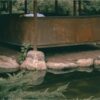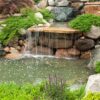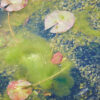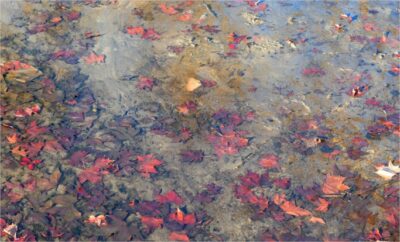Before we start talking about tricks to prevent green pond water, we must first determine the main cause of green water. Green water in your pond is most times, as a result, an alga with the botanical name Chlamydomonas (Chlamydomonas is a form of green algae comprising of about 325 species). Some of such algae are famous to pond keepers like a Blanket weed; scientifically called filamentous algae, also known as string algae or silk-weed. This algae can be single-celled or could be tiny particulates.
Algae is mainly a cause by excessive nutrients (overfeeding) and sunshine (not enough shade)
Another cause of green pond water is Planktonic Bacteria. Planktonic bacteria are free-living bacteria. Planktonic organisms include protists (simple, unicellular, or colony-forming algae primary producers and are most happy when it gets a lot of sunlight. This is why you can have clear water all winter, and then when the weather warms up your pond suddenly looks like a lifetime supply of pistachio milk!
What Sort of Problems Do Algae Cause In a Pond?
Green water algae aren’t dangerous to fish and other pond life. However, if not checked and just left to reproduce and multiply. The Algae will turn the pond water green, looking unpleasant and making it difficult to see your fish, newts, frogs, and other pond-life and aquatic plants. It can also be embarrassing when showing off your pond.
Blanketweed if left unchecked can cause serious issues in a pond, decreasing oxygen and is dangerous to fish and frogs, etc. trapping them in its slimy growth and it can also smother aquatic plants. In moderation, algae can provide great habitat for aquatic insects.
The main cause for both green water algae and blanket weed is high fertility from excessive nutrients, mainly from fish poo, uneaten fish food, organic debris, fertilizer run-off into the pond from higher ground, and fertilizers added to plants bought, insufficient shade in very sunny sites. An algae attack is normally worse in spring and summer, during sunny weather.
You know the saying… “Prevention is easier than…”
When you first dreamed up the idea of having the perfect pond, you won’t have thought for it to appear like pea soup! Unfortunately, that’s what most pond keepers go through. A backyard pond is a lovely thing to enjoy, especially when it is full of colorful koi fish. They’re a beauty to watch as that is one of the best parts of having a pond. In order to admire the fish, however, it is essential to have good clean/clear water. Green pond water is a well-known problem, affecting both the appearance of ponds and also the quality of the water they contain.
The good news is we’ve got 11 tips to help you prevent green pond water:
1. Keep a Good Amount of Fish
Most people will agree that fish are beautiful pets and feature to have in a pond.
However, the choice of what fish to add to your pond is only half of the job, then the right quantity to add is another. For those of you who are overstocked with the amount of fish you keep are built for disaster! More fish in the pond means more natural biological processes.
Fish then release more feces that forms the nutrients needed for green water to occur. You should enquire about the amount of fish fit for the volume of water in your pond. Retaining a decent number of fish for the size of your pond, there is less overload of waste, and the nutrients required for the growth of green water algae are reduced
2. Don’t Overfeed Your Fish
Nature does not like waste, because if there is plenty of food available, something will inevitably show up for the feast. Algae, like any other creature, need to eat, and a pea-soup bloom indicates that there is an imbalance in your water that nature is fixing on its own. An abundance of micro-nutrients in the water causes this imbalance. An overabundance of fish food is the most common cause of this waste.
Koi and goldfish will naturally forage for food, and they will be able to survive on their own without our assistance. While we enjoy it when our koi greet us at the pond’s edge and take food directly from our hands, we make sure to feed them only premium fish food with food-grade proteins and skip the bulking agents and binders that are less expensive. Premium food allows the fish to digest it more thoroughly, resulting in less waste in your water.
So, if you have green water, try not to feed your fish, or at the very least, limit your feedings to once a day, limited to what they can eat in five minutes, and make sure you’re feeding them high-quality food. Even if your fish seem to be begging for food, don’t give in, they’ll be fine on their own.
3. Provide Some Degree of Shade
Algae that cause green water are plants, and like every other plant, they thrive in the sun. Any pond that isn’t shaded from the sun will suffer as a result of this. Even if creating a pond with shade isn’t always the best option, there are still ways to get some. Aquatic plants that float on the surface, such as water lilies, are an excellent form. They provide partial shade to reduce sunlight exposure not only to algae but for fish such as Koi.
4. Use Beneficial Bacteria To Prevent Green Pond Water
As previously mentioned, algae are single-celled plant species that cause green water. This organism usually appears when the levels of nitrates and phosphates in pond water are out of control (high), supplying algae with the nutrients they need to grow and survive in ideal conditions. These nutrients are elevated as a result of some of the factors listed above, but they can be removed by using a beneficial bacteria treatment. Beneficial bacteria are bacteria strains that eat nutrients that would otherwise build up and fuel algae bloom.
5. Keep the Pond Aerated
Aeration devices can help beneficial bacteria break down and kill green water algae by increasing the amount of oxygen in your pond. They help to reduce carbon dioxide emissions by rising oxygen levels. So, the algae have less food and are sensitive to sunburn. Water features such as waterfalls, fountains, and even pumps and filters are excellent aeration devices. A waterfall is a great way to add oxygen to your pond, but if the pond is larger than 10 feet, the oxygen provided by the waterfall can not reach every corner. Adding a fountain or an aerator to any stagnant pond areas would keep those areas well-oxygenated and combat the algae that would otherwise flourish
6. Add Plants To Prevent Green Pond Water
A pond isn’t complete without aquatic plants, and they serve a function beyond aesthetics. By using nutrients in the water, the right plants will help the beneficial bacteria by starving algae. Thalia is the best plant for this. It grows quickly and absorbs a lot of the nutrients that would otherwise go to algae as food. Floating plants, such as water lettuce or water hyacinth, are also beneficial because they not only use up extra nutrients but also help block some of the sunlight that fuels algae bloom. Although water lilies are excellent at shading your pond, they are relatively bad at using nutrients. So, if all you have are lilies, you may want to consider adding something with a larger appetite.
A sufficient number of aquatic plants in your pond allows for greater absorption of nitrates created by fish excrement and food waste. This leaves very little space for algae to feed on nitrates, which they depend on. Floating plants will help provide shade and minimize sunlight in the pond, which will help control algae growth. Submerged plants can release oxygen into the water by clinging to a rock. Lilies and lotus are examples of floating plants, while hornwort, parrot feathers, and anacharis are examples of submerged plants.
7. Sunlight
We just spoke about how floating plants and water lilies can help minimize algae growth by providing shade. This is a simple change that can have a big impact, and it’s a lot simpler than planting a tree for the same effect. It is not always possible to locate the pond near a large shade tree, and when installing one near your pond, you must be cautious of rising roots interfering with the liner. Willows, for example, are infamous for having roots that can drill through and kill a pond liner. Another disadvantage to using trees to shade your pond is that they would undoubtedly add more organic debris into the water, which would have a detrimental effect on water clarity.
8. Rocks & Gravel
Rocks are an integral part of the ecosystem pond since they perform many roles. They protect the liner from UV damage, provide habitat for invertebrates and frogs, improve the natural appearance of the pond, allow your fish to forage along the bottom as they would in nature, and, most importantly, provide a large surface area for beneficial bacteria to colonize, Your pond’s biological filtration capability would be greatly increased. A 1.5″ layer of 3/4″ to 1.5″ rounded river gravel is recommended. This gravel bottom will develop a layer of green carpet algae, which is a good thing. The carpet algae will help to clean and keep the water clear.
9. Cleaning
Cleaning the sludge and muck that accumulates on the pond’s bottom on an annual basis is a vital aspect of keeping the water safe. The muck is similar to compost, and it’s chock-full of plant nourishing nutrients. The only way to prevent it from fueling algae growth during the summer is to remove it in the spring and/or fall. In addition to these deep cleanings, as the season progresses, it’s a good idea to remove any debris that falls into your pond. Those minor maintenance chores can have a significant impact on the overall water quality and Prevent Green Pond Water.
Water Treatment
As animal lovers, we are firmly opposed to the use of algaecides and prefer to use safe, non-toxic treatments instead. Chemical algaecides have the drawback of wiping out all of the algae at once, leaving a pond full of dead algae that simply feeds the next bloom. If being stuck in a never-ending loop of boom-bust isn’t bad enough, all that algae decomposing at once consumes all available oxygen, leaving your fish gasping at the gills and potentially killing them. It occurs much too frequently, and once the fish begin to show signs of a disease, it becomes a much more difficult problem to solve, assuming they can be rescued at all. This unfortunate situation could have been avoided entirely if algaecide manufacturers educated their consumers about the dangers of using their product.
Establish Harmony
When attempting to gain clarification, a common mistake is to quickly remove all of the green water and replace it with fresh water from the hose. Although this can produce immediate effects, they are not long-term. The same problems that caused the water to turn green in the first place will happen again, delaying the restoration of a sustainable ecosystem, as well as the unexpected shift in water chemistry brings the risk of shocking your fish.
Allowing the pond to build itself and all of the cooperating elements of the ecosystem to mature is a much better option; this increases the pond’s resistance to changes, whether they are environmental or intentional. The only time we usually replace water is during cleanouts, where it is customary to replace up to 50% of the water as part of the overall refresh, along with chloramine treatment and water monitoring to ensure the parameters remain within the optimum range for that pond.










